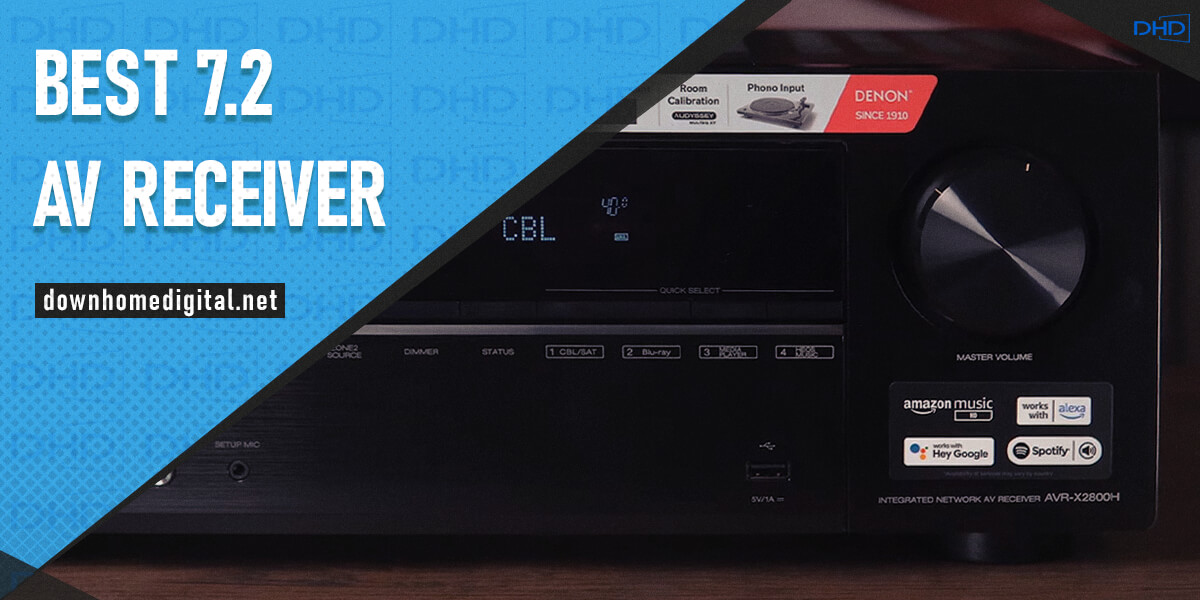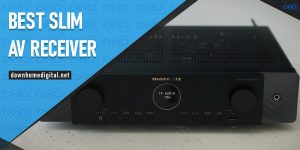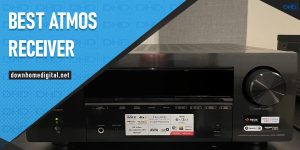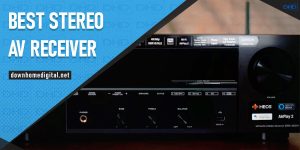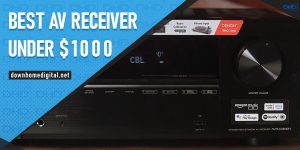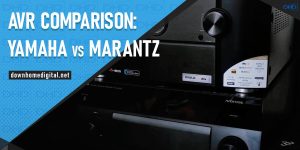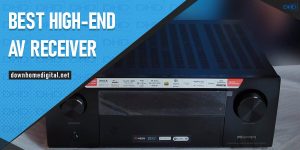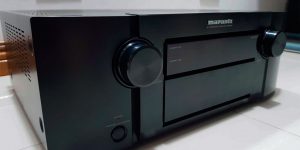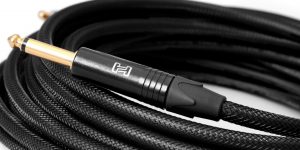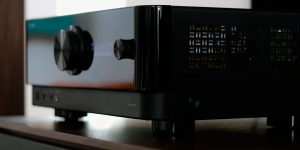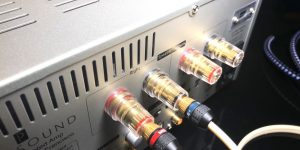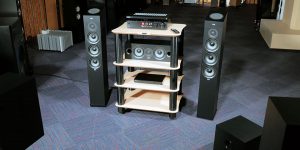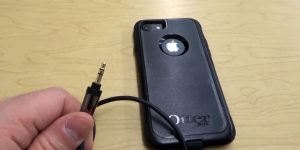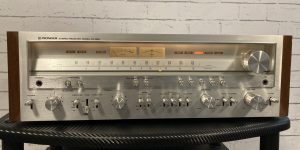An AV receiver can be called the heart of any home theater system. Nowadays, such devices have become genuinely universal and multi-functional, so you need to devote some time to grasp their peculiarities.
More and more people are looking for best 7.2 receiver, as this configuration allows you to enjoy surround sound fully. Moreover, only 7-channel receivers support Dolby Atmos, which puts them several steps ahead of their 5-channel counterparts.
If you have also faced the necessity of upgrading your sound system and need professional advice on how to choose a qualitative unit, make sure to read this review till the end. I’ve tested several popular models to narrow down the choice to 6 top 7.2 receivers. What’s more, I’ve highlighted their strong and weak points and explained what features you need to pay attention to while selecting a home audio receiver with 7.2 channels.

7.2 AV receivers comparison table
| Name | Channels | Power output | HDMI in/out | Bluetooth/Wi-Fi | Review |
|---|---|---|---|---|---|
| Denon AVR-X2800H best overall | 7.2 | 95W/8 Ohm, 125W/6 Ohm | 6/2 | yes/yes | Review |
| Marantz SR5015 premium | 7.2 | 100W/8 Ohm, 140W/6 Ohm | 6/2 | yes/yes | Review |
| Sony STR-DH790 budget | 7.2 | 145W/6 Ohm | 6/2 | yes/no | Review |
| Yamaha RX-V6A also a great choice | 7.2 | 100W/8 Ohm | 7/1 | yes/yes | Review |
| Marantz NR1711 smallest receiver | 7.2 | 50W/8 Ohm, 70W/6 Ohm | 6/1 | yes/yes | Review |
What are 7.2 channel systems?
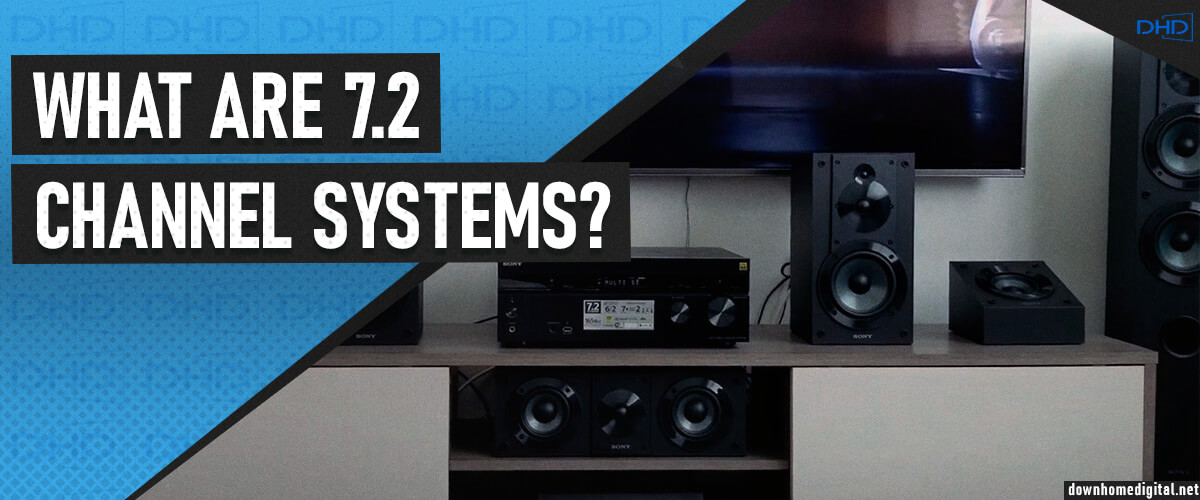
Considering the growing demand for this type of surround sound speaker layout, manufacturers actively develop the niche of 7.2 channel receivers.
Such a speaker system is developed based on a 7.1 setup, with the only difference being the number of subwoofers. In the case with 7.2 channel A/V receivers, they can drive 2 subs. The main reason for such an upgrade is the intention to even out the basses across the room. Longer bass sound waves can generate standing waves in the space, which results in the appearance of quiet and loud bass.
Of course, such fluctuations in the length of bass waves are something manufacturers want to get rid of. So, adding a second subwoofer to the basic setup is the easiest way to do so. Besides, such a system lets you put less pressure on a subwoofer, as now you have 2 standalone components, which can spread bass level more efficiently. As a result, you hear less overdriven sounds.
How I picked and tested 7.2 receivers
I decided to put both budget-friendly and top-tier 7.2 surround sound receivers to the test, to name those that will be the best value for money. I was mainly interested in how accurate and clear sound these models can deliver in various conditions and with different audio sources.
Since manufacturers claim that their products are equally powerful when playing music and watching movies, I aspired to check whether they can really succeed in both activities. So I watched Spider-man: Homecoming to evaluate the surround sound and the slightest variations in audio.
I also listened to tracks in different genres and from multiple sources to ensure the receivers can satisfy true audiophiles:
- Arctic Monkeys – Do I Wanna Know – SoundCloud
- Bob Marley & The Wailers – Turn Your Lights Down Low – Deezer
- Radiohead – The National Anthem – Spotify
- The Weeknd – The Hills (CD player)
- Led Zeppelin – Ramble On (CD player)
- Mahler – Symphony No.2 (CD player)
- Jacky Terrasson – Reach (CD player)
- Mark Nauseef – With Space in Mind (CD player)
I was determined to find the best 7.2 receiver, so I hopped from one piece of equipment to another, comparing the quality and clarity of sounding:
- CD player SACD 30n
- Blu-ray player Sony UBP-X700
- Speaker wire – AudioQuest Type-9
- Speakers for movie – Klipsch RP-8060FA
- Stereo speakers:
- Klipsch RP-8000F
- KEF Q350
- Sony SSCS3
Best 7.2 receiver reviews
Denon AVR-X2800H – best overall

The leader of my review is the Denon AVR-X2800H 7-channel AV receiver. Representatives of the brand often become winners in my ratings, as the company produces devices that optimally combine price and quality (functionality and sound). So, this 2023 model became a modernized replacement for the popular Denon AVR-X2700H, and repeating the latter’s success, it confidently took the leading position in sales. And I’m not at all surprised by that fact. But since the X2800H is a bit cheaper than the Marantz SR5015 (premium model), which is in second place here, some minor compromises await us.
Even though we are considering 7-channel receivers, which are representatives of the middle and budget price category, AVR-X2800H belongs to the most worthy representatives of the middle rank. This is felt even in its design, which I often pay attention to. Yes, the design is simple, as usual for Denon, but when I touch the volume control, I do not doubt that I’m looking at a high-quality product. The control is smooth, with no jumps in volume level, and that’s important, as you’ll see in later reviews.

The receiver is rated at 95 watts (8 ohms, 20Hz – 20kHz, 0.08%, 2ch). While this is not the highest data, the sound is nevertheless clear even at high volume. However, the compromise awaits you in the bass area. It’s because Audyssey’s calibration system (which is quite simple to operate) doesn’t see two separate subs but treats them as one. So you always get a 7.1 system. I’ll leave it to your judgment whether that’s important or not. But as far as I’m concerned, if the manufacturer has stated that I can connect 2 woofers, I want 2.
When it comes to video capabilities, the AVR-X2800H is a state-of-the-art device in its entirety. First, it has as many HDMI ports as the premium Marantz SR5015. 3 of the 6 inputs are designed to handle 8K video (version 2.1), and I really liked how the receiver handles the task. That’s a nice bonus for the category in question. The 8K scaling didn’t impress me; it doesn’t look like the original resolution, but it’s there. I rarely use this option in my daily life, to be honest. And I think most of the users do, too. Of course, there’s HDCP2.3 protection protocol, eARC lossless audio, and features for gamers. So, the model is quite suitable for a family with diverse needs. This also applies to the sound.
For fans of surround sound movies, I can say that you will get a great job with Dolby Atmos and DTS:X. I particularly experienced the vivid, dynamic, crisp reproduction of each sound layer’s details when watching Red Notice. I like hearing the specificity of the main characters’ voices without adjusting the sound for action scenes. The sound is balanced, with each signal reaching its point in space, which is especially good for a small system. I also liked the option to listen to sound through the speakers and headphones at the same time. I think hard-of-hearing members of your family will appreciate this. If your room lacks ceiling-mounted speakers, you can also use the immersive DTS Virtual:X and Dolby Atmos Height Virtualization formats. I didn’t hear much difference in the soundstage, so for the average user, there will be no difference at all. This is rare for 7-channel receivers.
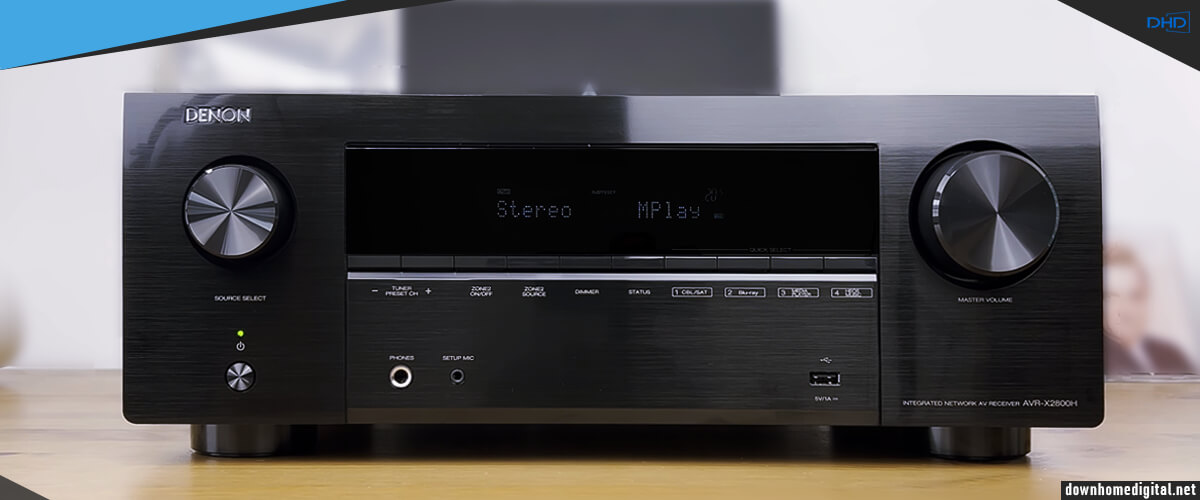
Stereo I tested the receiver with wireless technology. I want to note the high signal quality, although Wi-Fi and Bluetooth are quite common today. I decided to test the system with slow tracks (Bob Marley & the Wailers – Turn Your Lights Down Low, The Weeknd – The Hills) and dynamic sounds (Arctic Monkeys – Do I Wanna Know) and was impressed with its capabilities, as the instruments sound like they were recorded directly from my studio, where I do my research.
I sometimes recommend a combination of receiver and speakers, and for the AVR-X2800H, the Klipsch RP-6000F II front speakers were the perfect result. In addition to their unique technologies like 90° x 90° silicone composite hybrid Tractrix horn and cerametallic woofers, which emphasize the brightness and warmth of the Denon sound, the speakers also have simple hidden connectors on the rear panel for connecting Dolby Atmos speakers. This is convenient and saves you the hassle of ceiling connections, and the soundscape still retains its charm and nuance.
Denon AVR-X2800H is presented in my selection as the winner among the best receivers with 7 channels of amplification. If you are a follower of the optimal price/quality ratio, do not like to save money, but do not want to overpay for the “name”, this model can offer you all modern major formats of surround sound, wireless connectivity, and video.
It’s equally good for movies, stereo, and console gaming, as all of its claimed features work better, if not flawlessly, compared to the rest of the rating (except, perhaps, Marantz). Having overpaid a few hundred dollars relative to budget options, you can build with AVR-X2800H a system that will not need to be upgraded.
| Power |
|
| HDMI features |
|
| Video features |
|
| Network |
|
| Surround sound processing |
|
Pros
- Optimal value for money rating.
- Unlike some of the more budget-list models, the design inspires confidence.
- Audyssey is easy to operate; even a novice user can handle it.
- HDMI 2.1 has a modern interface and qualitatively transmits 8K resolution.
- Audio can be listened to simultaneously from speakers and headphones, which can be useful if a hard-of-hearing person is in the family.
- The immersive DTS Virtual:X and Dolby Atmos Height Virtualization formats are virtually indistinguishable from those used by the ceiling speakers.
- Wireless connectivity showed good signal stability and quality performance across genres.
Cons
- Audyssey’s calibration system treats the 2 subwoofers as a single unit, so we’re discussing a 7.1 system.
Marantz SR5015 – premium

Marantz SR5015 is a 7.2-channel AV receiver in the updated SR-line. The brand’s products are always the highest quality in construction, and the receiver is very similar to the leader of the Denon AVR-X2800H selection in terms of features. However, it is more expensive than my winner. Now, I will tell you why, and you will decide whether it is worth spending a fairly decent amount of money on it.
This Marantz model doesn’t really appeal to me in terms of design, especially since I always point out that ridiculous round LCD. Yes, it looks nice on a store shelf, but you can’t see anything from 10 feet away. The control buttons are brought to the bottom of the front panel, which is convenient, in my opinion. It’s like playing a keyboard instrument; they even stick out a little bit. Otherwise, the brand is true to its traditions – elite in everything. Good ventilation and high-quality internal components. I quite often mention Topology with Current Feedback and Hyper Dynamic Amplifier Module, which make the sound of Marantz recognizable and unsurpassed in quality, even when it comes to relatively inexpensive devices (SR5015 is a representative of the middle segment but premium among the receivers with 7 channels of amplification).
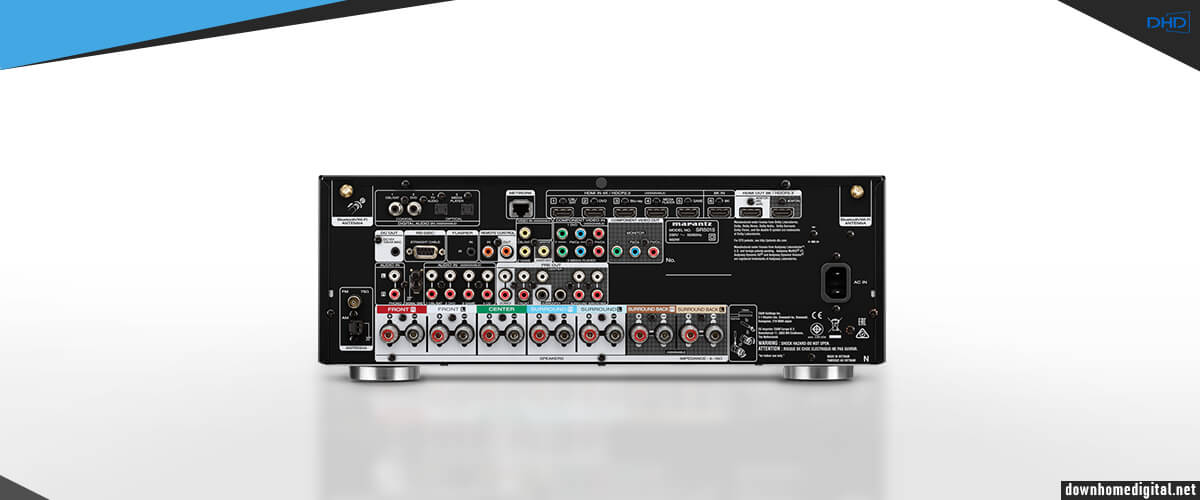
The developer has worked hard to make this receiver as powerful as possible, and I was inquisitive whether it could cope with all the tasks I’d prepared for it. All channels are equipped with discrete high-current amplifiers, so you get 100W with 8 Ohm speakers and 140W with 6 Ohm analogs. Thanks to the low-impedance driver, you can pair the receiver with a wide variety of speakers and always get a balanced sound. I like an Auto Eco Mode that automatically handles the power output to speakers by evaluating volume level and on-screen eco meter. That’s really cool.
Some users reported problems with screening video content in 8K at 60Hz, but I didn’t experience any difficulties. Everything was smooth and crisp. If you are dissatisfied with video quality, you should try Dynamic HDR and Quick Media Switching that are available in this version.
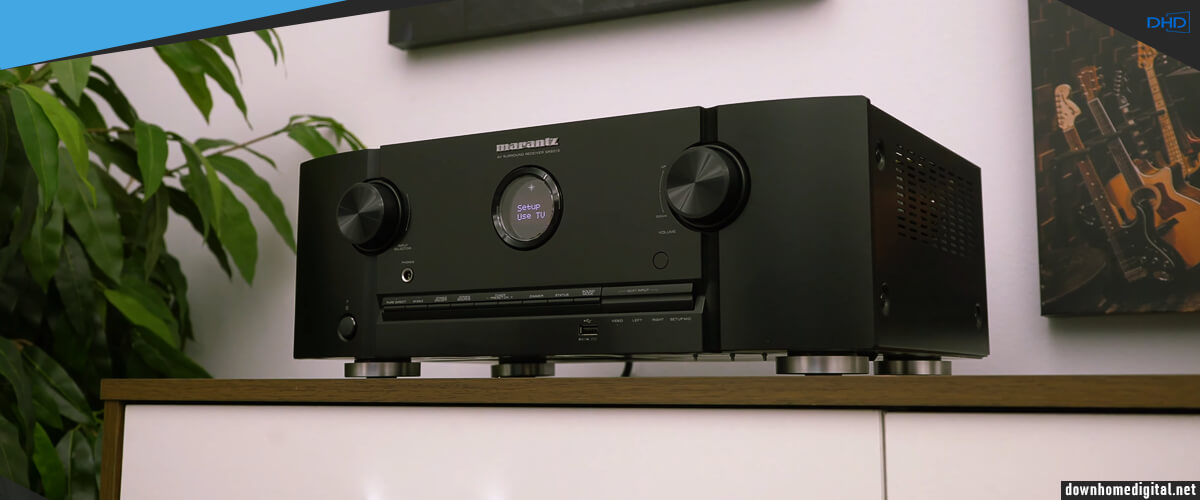
I’ve put this receiver to the harsh test and listened to all the compositions listed above several times and from different sources. Just WOW! You can hardly confuse Marantz’s native sound with other receivers. It is so rich and melodic with an exquisite sonic signature. The quality of sound far surpasses Denon AVR-X2800H and Pioneer Elite models.
As for surround sound, Marantz SR5015 is not much better than Denon AVR-X2800H for an ordinary user, but I can see the difference in my equipment in the studio, where I can observe the dispersion on the graphs. To explain in simpler terms, the soundstage is tighter and smoother, but only a pro can hear this with the ear, as we are talking about a fairly simple system. Nevertheless, the brand has a uniquely warm sound that makes watching movies as realistic as possible. When watching The Haunting of Hill House on Netflix, I could hear every movement even if I didn’t have time to follow it in the picture (I’m referring to the background movements of the ghosts behind the main characters). Every rustle was creepy, as it should be, making me, a seasoned movie buff, covered in goosebumps. At one point, I even found myself with my mouth ajar, so immersed was I in the story.
All in all, I can call Marantz SR5015 the best 7 channel receiver for anyone who can afford to buy such a premium device. The multi-dimensional audio output guarantees a refined sound stage in any environment, especially when paired with Dolby Atmos and similar systems. The HEOS technology lets you enjoy uninterrupted audio across several rooms or define a particular music zone.
You should realize that you’ll pay a couple of extra hundred for things you won’t see and probably won’t hear, but the quality of Marantz has not been surpassed by any brand yet. It’s also worth remembering that high-end stuff requires high-end accessories. Yes, the receiver is so good that the system sounds great with any acoustics, but do realize that you will want more with it, so get ready for additional expenses on cables and speakers.
| Power |
|
| HDMI features |
|
| Video features |
|
| Network |
|
| Surround sound processing |
|
Pros
- Thanks to its low-impedance driver, the receiver can be paired with various speakers and always produces a balanced sound.
- Auto Eco Mode automatically adjusts the power delivered to your speakers.
- Dynamic HDR and Quick Media Switching improve video quality.
- Quality internal components make the SR5015 sound top-notch and more detailed than other models in this selection.
Cons
- You’re paying for things you won’t see or hear.
- Small, unreadable LCD.
Sony STR-DH790 – budget

People often get carried away by expensive receivers, but more affordable models can also please with interesting features. Sony has excelled at producing electronics to suit every budget, and I decided to take a closer look at a low-cost Sony STR-DH790.
I want you to understand that if we are talking about a budget device, you can’t expect even approximately the same quality as the premium models of the 7-channel receiver category. Sony STR-DH790 looks like a technique from the 90s, in which you can feel cheap plastic. Buttons and regulators fall, slip, and do not inspire confidence, as if they are about to fall out of their grooves. This is quite normal at a price 3-4 times lower than the leaders of my selection. The remote control will save you from unnecessarily touching the receiver with your hands.
The first thing that catches your eye when looking at the box is the inscription “145Wx7”. That seems impressive, but you need to understand that power is an ambiguous indicator. In general, you can expect 145 watts with 6 Ohm speakers, but THD is 0,09%.
The model has 7 channels, which are strategically organized to allow you to bi-amp a front pair of stereo speakers or get surround sound from a pair of rear/height speakers in Dolby Atmos and DTS: X format.
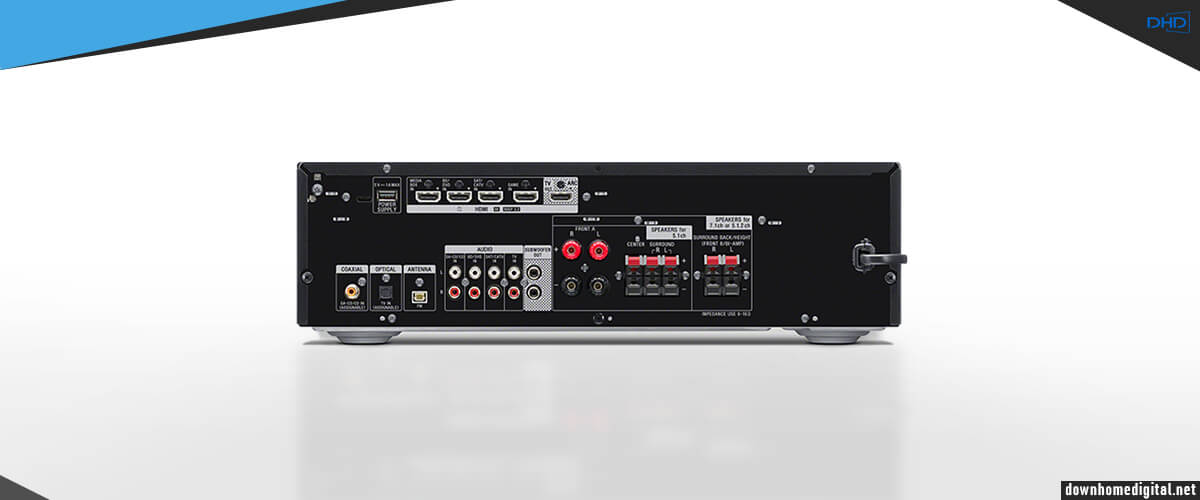
I noticed that the developer called for a kind of compromise. All channels except the front left and right use spring-loaded terminals rather than screw terminals, which require cables up to 1.5 mm in diameter. I don’t understand such a move.
The model has 4 HDMI inputs, which support signal quality up to 4K at up to 60Hz, HLG and Dolby Vision, 3D, Deep Color, and BT.2020 color space. There is only one HDMI output.
STR-DH790 lacks some elements that users are likely to need. I was astonished that there is no support for the second zone (zone B). If that is a serious problem for you, opt for Onkyo TX-SR494.

Despite all the described compromises, STR-DH790 is on my list for a reason. While testing this model, I used Sony’s auto-calibration feature, which worked surprisingly well, suggesting that the receiver is designed for the inexperienced, unsophisticated user. I watched the movie Spider-Man: Homecoming and fully appreciated the charms of the object-oriented Atmos format, as I could even track Spider-Man’s trajectory. The receiver sounds just fine for its price (I emphasize this).
The music quality was also pretty good. I tested the receiver in Stereo, Direct, and Pure Direct modes, as well as in the standard All Channel Stereo mode, and I was quite satisfied with the signal quality. STR-DH790 retains many details of the original track, giving it a certain coldness of sound (but not like Yamaha), making the sound seem cleaner than it really is. But let’s be honest to the end: if you listened first to Marantz SR5015 and then to this receiver, you will obviously hear the difference, which is not in favor of the latter.
Since the sound of the most inexpensive receiver in my selection isn’t perfect, it needs the right speakers. And I recommend the Sony SSCS3. Perhaps Sony knows the secret, but when paired with them, the receiver reveals its full potential. I can’t say that the system starts to sound at the premium level, but the sound with this combination became clearly brighter and clearer; I heard some details in musical compositions that were missing with other speakers.
This model is great if you are a novice home theater user. It sounds pretty good in movies and music, especially with the right selection of speakers. Let’s say convincingly and without bright signal dips. It does a good job of delivering 4K video. It doesn’t have many features, especially regarding audio streaming processing, and isn’t overly reliable. But these compromises are acceptable for the money you’ll spend on it, as most of you won’t notice the waste. You can use it in your garage, kid’s room, or guest house. I’m sure there will be a use for it.
Sony STR-DH790 is the best budget 7.2 home theater receiver for home theater, providing high-quality Dolby Atmos and DTS: X surround sound, as it does its main task without irritating installation, setup, and, actually, listening.
| Power |
|
| HDMI features |
|
| Video features |
|
| Network |
|
| Surround sound processing |
|
Pros
- It is possible to mute or raise volume for each speaker.
- The multi-tap transformer and multiphase DC switching is noiseless.
- Can decode the newest formats and pass through 4K HDR.
Cons
- The receiver’s build quality is significantly inferior to more expensive picks.
- Configuration isn’t “on screen”, so you have to navigate through a one-line LCD menu.
- Poor ventilation.
- No equalization.
Yamaha RX-V6A – also a great choice
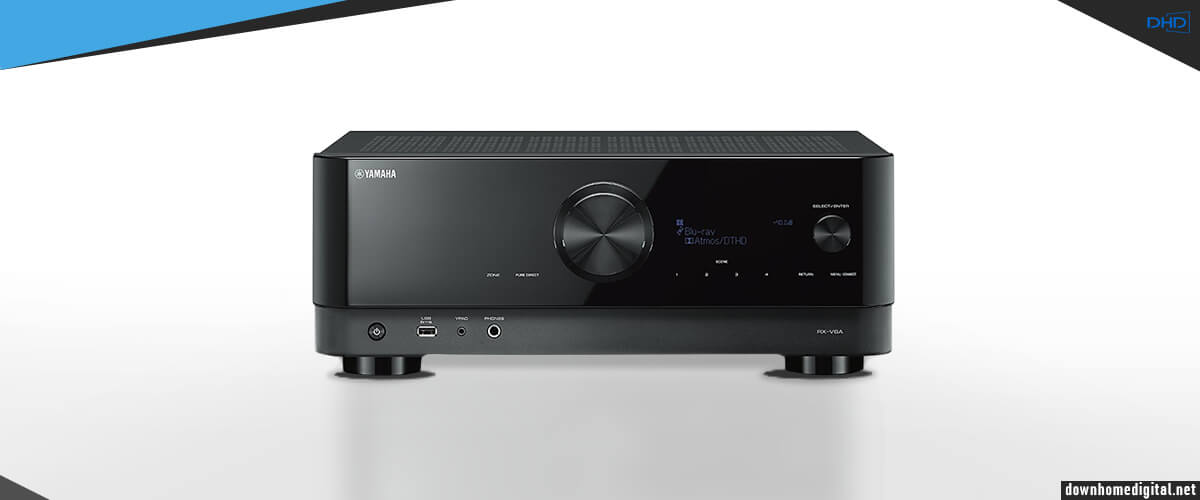
Yamaha RX-V6A is a good receiver for creating a modern home theater as it has all the major features at a reasonable cost. The main upgrades I noticed compared to the younger model (the RX-V4A) are the 7.2 configuration and support for the new surround sound formats – Dolby Atmos and DTS:X. The power output reaches 100 watts at 8 Ohm.
Every time I describe this model, my feelings about its design are split in half between positive and negative. It really looks great, standing out among the crowd of monotonous black boxes, thanks to its glossy front panel and rounded sides. But that same glossy look annoys me, and I usually use gloves when working with it because the buttons are touch-sensitive. I also don’t understand the dim LCD in the corner. If fingerprints and every speck of dust do not freak you out, just let my comments pass you by. To be honest, I had trouble with the remote control, which occasionally lagged, froze, or required strict direction to the receiver.
This model has seven HDMI inputs (3 of which support 8K) and one output that supports 4K Ultra HD with all the Dolby Vision and HLG add-ons. The device is also equipped with analog and digital inputs, which make it possible to create an AV system with a variety of signal sources. For my test, I used the SACD 30n CD player and Sony UBP-X700 Blu-ray player.
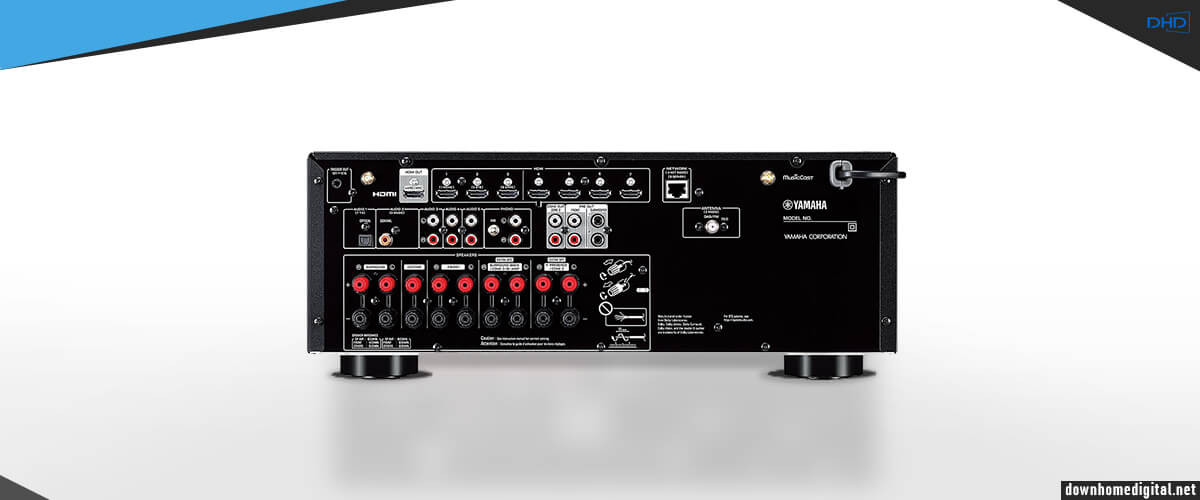
Yamaha RX-V6A employs a proprietary YPAO auto-calibration scheme for convenient, multichannel sound tuning, taking into account the parameters of the room and acoustics. I also took advantage of the bi-amping option. It amplified the high and low-frequency bands of the front left and right speakers with independent amplifiers, thereby enhancing the sound quality of the front channels.
Thus, while watching The Hitman’s Bodyguard, I could hear gunfire and explosions perfectly, and it felt like everything was happening in my studio. There is enough power and dispersion to create a realistic experience, making the viewer flinch at sudden sounds or duck out of the way of side sounds. This was great. The Zone B output allows you to send 2-channel audio to another room. I tested this feature and played back audio from the same source in two different zones.
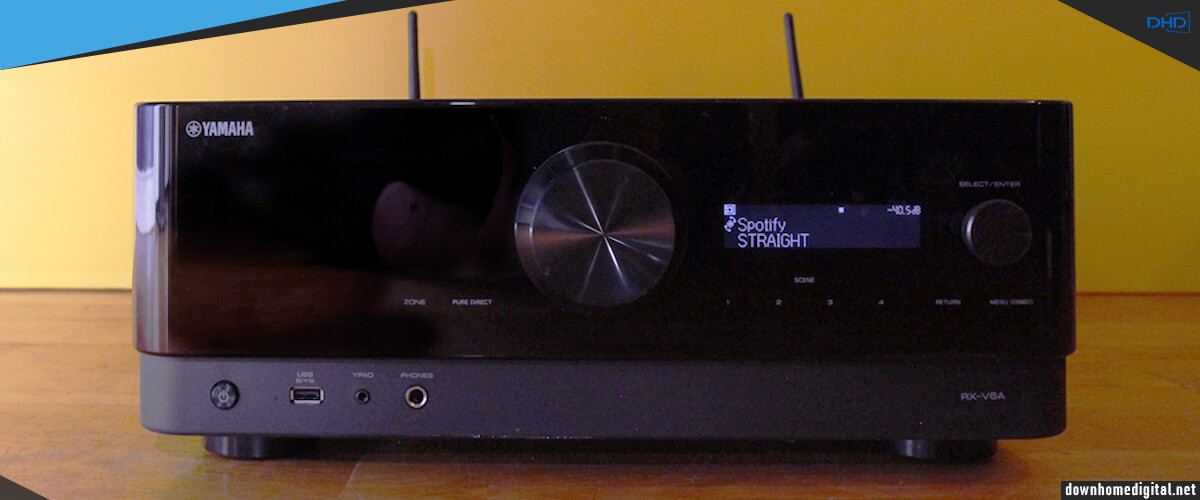
It is worth noting, however, that in my opinion, the Yamaha has a too-cold, crystalline sound, which I also often write about. Yes, this is a subjective opinion, and perhaps that’s the only reason why RX-V6A didn’t take the first position in the rating (well, because of the glossy panel, damn it). I appreciate this sound, and I can appreciate its quality. Still, for me, it is good only in heavy genres of music because it emphasizes the necessary grinding, distortions of musical instruments, and even the performers’ vocals.
I often consider Yamaha models as an alternative to the leader of choice because this brand produces really high-quality equipment. Therefore, I honestly admit that my choice is almost always subjective and based on my personal preference for the warmer sound of Denon.
In this case, we are not dealing with direct competition because the RX-V6A is twice as cheap as the Denon AVR-X2800H. Nevertheless, I am obliged to say that it is a good option. Rather, I’d compare it to the budget Sony STR-DH790 and Onkyo TX-SR494, and I’d advise you to choose it if you have a couple hundred dollars more to spare. It’s worth it, folks.
Therefore, I believe the Yamaha RX-V6A may be the best 7.2 receiver for those who want to upgrade their current home theater system and are fans of crystal-clear sound. In addition, this brand has a unique concert sound technology that gives you an unreal stadium or concert hall feel that no other brand has.
| Power |
|
| HDMI features |
|
| Video features |
|
| Network |
|
| Surround sound processing |
|
Pros
- Different sound modes (e.g., Theater, Conference Halls) can add a different feel when listening to music.
- Comes with a Dolby Surround upmixer to expand audio to all channels evenly.
- Multipoint Measurement room correction system.
Cons
- Laggy remote control.
Marantz NR1711 – smallest receiver
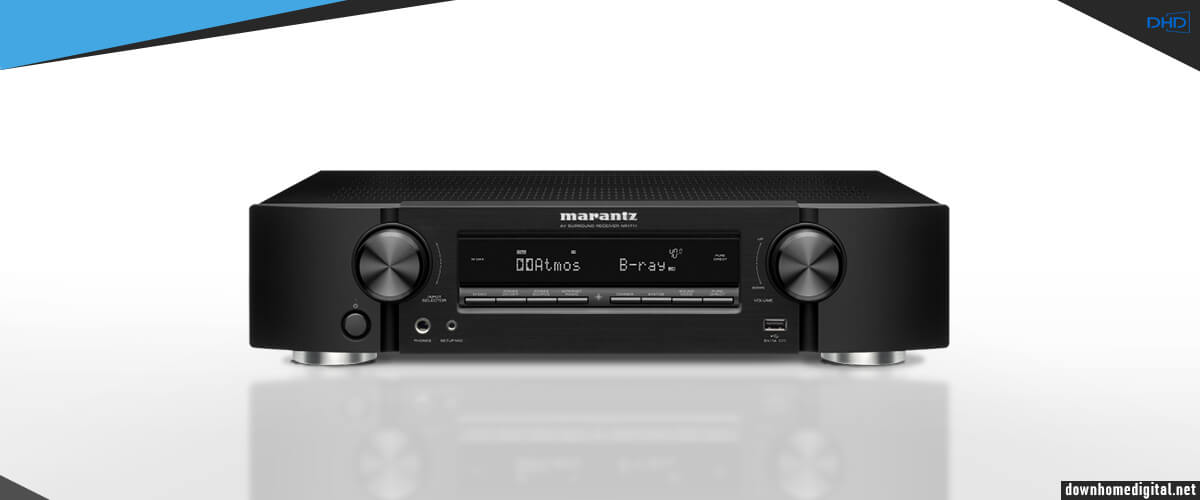
This compact receiver was initially designed exclusively for casual needs. But over ten years of constant modifications, it has become a functionally flexible and reasonably priced apparatus that you can use to build a state-of-the-art home theater.
First of all, I will draw your attention to the fact that Marantz NR1711 has a narrow design, which means that it will fit into a compact rack, a narrow shelf, or a small-sized apartment because its power is understated relative to other 7-channel receivers of the selection. You should also realize that in small devices, all internal circuits are located close to each other, which increases the risk of additional noise and overheating during prolonged operation. But we are dealing with Marantz, which means that they have avoided such problems. Nevertheless, there is a slight overheating, and I recommend putting the receiver on an open surface. But NR1711 has a normal LCD, unlike the premium Marantz SR5015.
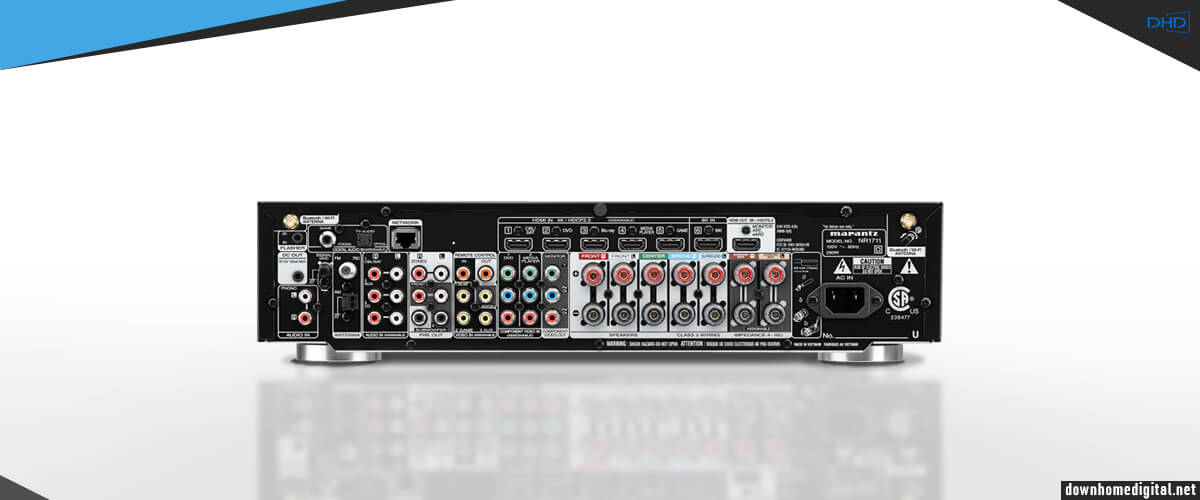
When I first saw this receiver, I didn’t expect much from it. However, the manufacturer added an HDMI card that supports 8K/60Hz on one of the inputs and 4K/120Hz on the other five.
By the way, it brags about high-speed “gaming” HDMI specifications and support for eARC (return audio channel for object sound formats). The power output is measured at 50W/8Ohm and 70W/6Ohm, which is the smallest indicator in the rating but determines the clear sound despite the compact size.
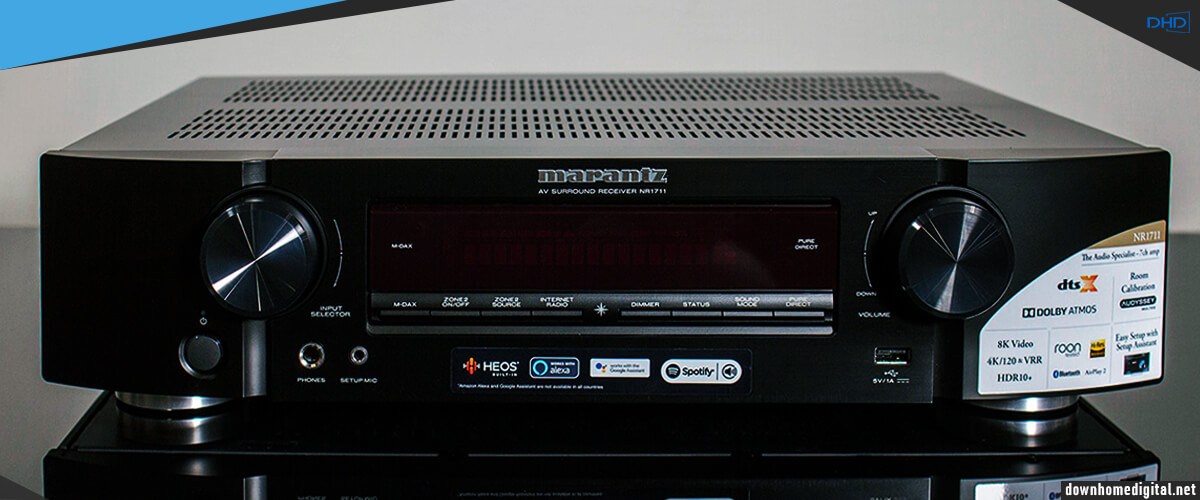
While watching the movie, the sound stage was pleasant and balanced, with smoothened basses and softened high frequencies. If you don’t like such a gentle sound reproduction, go to the Audyssey menu and turn off the equalization of the frequency response. Then turn on the graphic equalizer and slightly tweak the sound of the entire system or each channel separately.
Music playback is not as effective as in Marantz SR5015. It lacks fine resolution and harmonic purity. I tried to switch on Pure Direct to improve the quality of sounding, and that actually helped. There is also a proprietary M-DAX2 enhancer.
Marantz NR1711 will appeal to you if you’re a fan of high-end stuff, even if it comes with limited features. You pay for an expensive device, but you get a smaller version of it, which is convenient if the size of your apartment does not allow you to build a large system. The receiver will not provide you with a sound picture similar to that of full-size models because its power is halved. But the sound is high quality, clear, warm, and pleasant.
In video and wireless functions, you get a thoroughly modern device with a package of the most popular features aimed mainly at movie buffs, not music lovers. The NR1711 could be the centerpiece of your home theater, as it’s the best 7.2 AV receiver with a narrow design you can find.
| Power |
|
| HDMI features |
|
| Video features |
|
| Network |
|
| Surround sound processing |
|
Pros
- Has 12V trigger out & pre-out connections to hook up an external amplifier.
- Slim design allows for placement in tight spots.
- Perfect for driving smaller speakers and giving them a huge presence in a small space.
- Has HEOS, so you can stream directly from Spotify, Apple Music, etc.
Cons
- Loses a video signal when switching video sources.
- Smallest power in the rating.
- Slightly overheats, requires an open place for installation.
- Troublesome setup.
Onkyo TX-SR494

Onkyo TX-SR494 is an improved variant of a younger model TX-SR393. The number of channels here has increased to seven. In addition to the updated design, Onkyo TX-SR494 has a modified set of connectors – in particular, the manufacturer removed a USB port for connecting portable drives with music files.
The Onkyo receiver does not evoke an unambiguous opinion about cheapness for such a budget device. No, of course, it is not comparable to the selection leaders, but still, its construction seems more reliable than that of the Sony STR-DH790. TX-SR494 looks like a slightly unhewn but good log, in which you can see the potential of reliability. The volume control is a bit tight, but I didn’t see any skipping of values, and for me, this is an important indicator. But treble and bass are regulated by buttons, which I don’t understand even in inexpensive models because there is no question of individual adjustment.

The AV receiver is equipped with four HDMI inputs and one output, capable of transmitting 4K UHD signals, including Dolby Vision, HDR10, and HLG. Still, I did notice some lag when streaming high-resolution video, which is acceptable for this level of hardware. The device also has three analog and two digital inputs. The advertised power output is 80W with 8Ohm speakers.
This model is equipped with AccuEQ Room Calibration, which is a rare feature in the models of this price segment. The device has HD-surround sound decoders and high-quality modern DACs from Burr-Brown.

Although I’ve mentioned that I don’t like push-button frequency switching, the options the receiver offers are nevertheless quite acceptable to the average person who doesn’t know the nuances. I took full advantage of these functions when listening to Mahler’s Symphony No.2, Mark Nauseef’s With Space in Mind, and Jacky Terrasson’s Reach. Let me tell you – the sound is fine. As for stereo, it’s great. It doesn’t have any specificity, and it’s not too detailed. But the overall picture didn’t seem mixed to me. While doing household chores, I think it’s quite suitable for background accompaniment, although it sounded a bit dim in my studio. If you want to use wireless, the Bluetooth let me go 5 feet away with my phone in my pocket, and further, the signal began to be intermittent. And there’s no Wi-Fi at all.
Regarding the quality of surround sound reproduction, the receiver can quite compare with the Sony STR-DH790, so your choice will come down to brand preference. The receiver improved the TV’s sound, brought the main tracks to the foreground (dialogs, stereo), and directed the necessary channels to the surround sound speakers. For its price, it does the job.
By choosing the budget Onkyo TX-SR494, you invest money in modern but basic equipment while not ruining your pocket. In terms of the Sony STR-DH790 it can be compared to, it looks more robust and sounds less specific, giving a wider range of users to love it.
I can recommend this 7.2 receiver to users who don’t have high demands for this kind of equipment. It handles normal tasks well and has the necessary features to view modern content. But this is not your option if you want to use wireless technology.
| Power |
|
| HDMI features |
|
| Video features |
|
| Network |
|
| Surround sound processing |
|
Pros
- Has the power to drive 7 speakers without being obnoxiously loud.
- Reproduces excellent Dolby Atmos sound when watching movies.
- Microphone AccuEQ Room calibration.
Cons
- There are some delays while streaming high resolution video.
- Bluetooth doesn’t work past 5 feet.
- No Wi-Fi.
Buyer’s guide
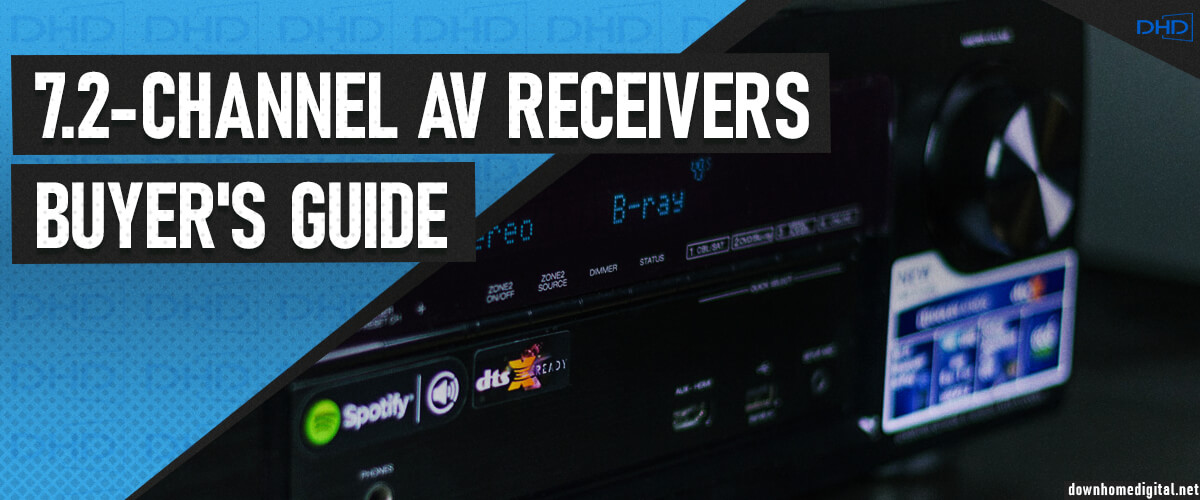
How to set up a 7.2 surround sound speaker system?
The prototype of a 7.2 layout is a 7.1 surround sound speaker system with 1 subwoofer. Since the release of the first 7.2 receivers, such devices are gaining more and more popularity thanks to an evenly spread level of bass, which is possible thanks to the inclusion of the second woofer.
Leading manufacturers are enthusiastic about creating 7.2 receivers, so a huge variety of offers positively affects the cost of these devices. In other words, they are more affordable than “forefathers”.
If you want to get a good 7.2 surround sound receiver, you need to clearly understand how every setup component should be located. You can experiment with changing the distance of the speakers from the wall. The closer they are to the wall, the more the bass is amplified. This can be good, but only to a certain extent. Also, the overall sound quality can be improved if you move the speakers further away from the wall. Try several different positions to see which one provides the greatest results in your room.
I will also give a few general recommendations for the positioning of your system:
- Do not place speakers near power amplifiers, heaters, or other devices that produce a lot of heat.
- Do not place your speakers in very humid or dusty places or direct sunlight.
- The speakers provide the most accurate soundstage when the angle between you and the speakers is between 40 and 60 degrees.
- The finest stereo sound is obtained when the speaker is in a vertical position.
Here are a few more recommendations on how better to use a subwoofer. Since bass frequencies are omnidirectional, you can choose any subwoofer location that suits you. Remember that placing it near a wall usually generates lower frequencies. Placing it near a corner allows for an even greater effect.
Using two subwoofers improves low-frequency distribution, filling gaps where low-frequency reproduction may be weak. The second subwoofer also provides more impressive dynamics, filling the room with more bass. The location of the second subwoofer in your room can be determined using a special layout. In some rooms, you can get better results by placing a subwoofer in each of the room’s front corners. In other cases, a more even distribution of bass frequencies is achieved by placing one subwoofer at the front of the room and another at the back. Try a few different options to see which one will give you the most optimal bass in your room.
Almost all receivers I tested have marked inputs. Denon AVR-X2800H even has color-coded inputs, which makes the process of connecting 7 speakers and subwoofers a breeze. Connectors for optional rear and front speakers can also be used for Atmos speakers.
If you want to play 4K HDR content, look for HDCP2.2 above the HDMI input. Some models have only a pair of HDCP2.2 – certified ports. You may also notice that each HDMI input has an assigned source: Blu-ray, DVD, CD, game console, cable/satellite, media player, etc. This isn’t just a simple recommendation. It means that a manufacturer has optimized the characteristics of these inputs for specific sources.
Do I need a second subwoofer?
Subwoofers used in theaters are huge, but you don’t need such bulky units at your home. Getting something more space-saving is a better option.
Of course, you can achieve piercing energetic bass with one good sub if it is in the right place and you have a quality 7.1 receiver. However, there are undeniable advantages of setups with two subwoofers. I will highlight 3 main of them:
- Uniform bass at any listening position.
- That’s the first and foremost advantage. Two subs provide a balanced bass output throughout the room. This is achieved by eliminating the so-called “zeros” that occur when two sound waves of one subwoofer cancel each other out at a certain point and, consequently, create the effect of missing bass.
- Increased dynamic capabilities.
- Perhaps this point is the most obvious: the power of two active subs produces a greater dynamic range, increased sound pressure levels, and generally deeper, more impactful bass that you can hear and feel with your whole body.
- Space-saving.
- Two small subwoofers can be easier to place than the large one. As a result, not only these compact devices are better at what they do, but they are also easier to install.
Perhaps switching to a dual-sub system will be the most noticeable change-improvement to your home theater or music installation. It’s the most optimal way to fill a room with precise, punchy bass that feels like it’s coming from all the speakers.

